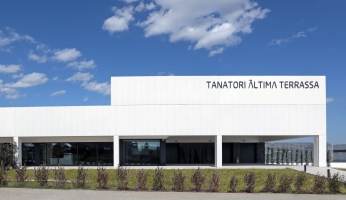Caitlin Doughty describes in detail numerous funerary practices from around the world in her book “From Here To Eternity.” One of the stops she makes is to the Altima funeral home in Barcelona, Spain. Here she learns about the Catalan practice of staying with a loved one who has died for an entire day, behind glass divides.

Credit: altima-sfi.com
According to Doughty, the Altima funeral home handles roughly one quarter of all deaths in Barcelona. This comes out to an average of ten to twelve bodies a day.
The Altima funeral home offers 20 “family rooms” that families can rent in order to spend a final day with their loved one who has died. They can choose to stay as long as they want, with many families staying until the home closes at 10 pm. There are two styles of glass that families can choose: the Spanish-style viewing or the Catalan-style.
Loved ones who have died are kept in open, traditional coffins for both methods. The Spanish-style puts the person who has died behind a large pane of glass, similar to a department store window. An open coffin is slid into a display case (almost like a larger, see-through coffin) in the center of the room for the Catalan-style.
Doughty writes of how the people in Barcelona she spoke to feel everything about death is a bit too rushed. The death, the final day with the loved one, and the subsequent burial or cremation all usually happens within a 24-hour cycle. Bodies are very quickly buried or cremated, so embalming is a rarity in Spain. Embalming only occurs when a body will be transported to another part of Spain or another country.
Burials
The method of burial Doughty experienced in Barcelona is also quite different than the typical Western style.

Cementiri Parc Roques Blanques
Credit: altima-sfi.com
For instance, she visited the Cementiri Parc Roques Blanques, one of Altima’s cemeteries. (Doughty mentions that Spanish cemeteries are public, but companies like Altima can contract to run them for a certain length of time.)
There, the bodies of people who have died start out in a ground grave or in a wall mausoleum. However this is not their final resting place. Families of the person who died rent out these spaces for a minimum of five years to allow the body to decompose — another reason that embalming is so rare. Embalmed bodies can take upwards of 20 years to fully decompose.
Once fully broken down to the bone, the decayed remains are transferred to communal pits carved into hillsides of the cemetery grounds. These hillside holes are hidden beneath metal manholes that are padlocked shut, shielded from public view. The collection of final remains also include cremated ashes.
Cremations
The cemetery Doughty visited in Barcelona has two cremation machines, and families can choose to witness cremation if they choose. According to Doughty, 60 percent of the families choose to view the cremation at this particular cemetery. This number is much higher than in the United States, where many people don’t even know that this is an option.
Being behind glass is part of the cremation process at Rouqes Blanques. Families are separated from the machine by three panes of glass that stretch from ceiling to floor. People are able to see the cremation machine itself, but the angle of the glass is designed so that they can’t quite see the flames. Though they can’t really see inside and witness the entire process, it’s important to the families that they can be involved.
That is perhaps one of the biggest differences between the Catalans’ use of glass and the way things are done in the United States: families are involved in the process of death. Though the glass offers a sort of barrier between families and their loved one who has died, they are still with the body until the end. The use of glass enables families to witness the reality of death and allows transparency. It also offers a solid barrier, which some people may need to feel comfortable being that close to death.

 Behind Glass — A Barcelona Death Ritual
Behind Glass — A Barcelona Death Ritual


 “As Tears Go By” by Marianne Faithfull
“As Tears Go By” by Marianne Faithfull

 Funeral Favors Offer Visitors a Tangible Memento
Funeral Favors Offer Visitors a Tangible Memento















